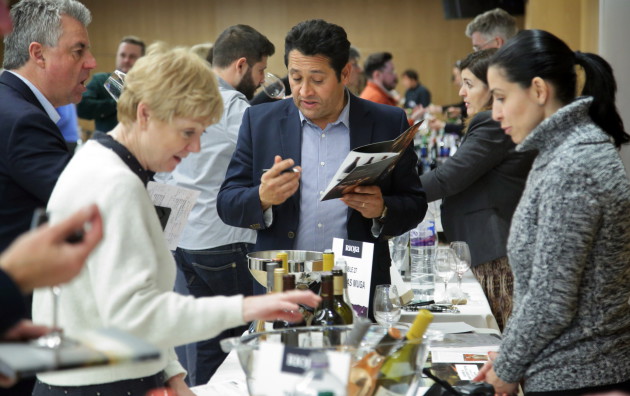
Rioja's white exports grow, but overall market dips
The growth of Rioja’s white wines is paying dividends for the region in the export market, finally making good on a promise that the DO is able to diversify its portfolio abroad. However, things are looking a little less rosy globally in 2022, with uncertainty in various key markets leading exports to take a tumble.
Harpers was there to catch up with all things Rioja at yesterday’s 100km of Diversity tasting – a new title for an annual format, which aims to show the breadth of stylistic and varietal diversity of Rioja’s three sub-zones.
What emerged was a region that is very much aiming to show that it can connect with consumers beyond its wheelhouse of classic red, aged styles, pushing not only into whites but also a more premium category courtesy of its Viñedos Singulares designation, which now totals approximately 200ha from 80 producers across 150 vineyard sites.
Until this year, it seemed this strategy was paying off. The year 2021 was a strong one for Rioja globally, with value rising 8%, partly due to a bounce back from a dour 2020. However, while sales are forecasted to remain flat in the domestic market for 2022, export is also struggling, with difficulties in several major markets creating headwinds.
“Difficulties in China and Russia have had a big impact,” Iñigo Tapiador Larrañaga, global marketing and communications director at Rioja's Consejo Regulador, told Harpers.
“The UK has also not been great, because of uncertainties in the tax structure for next year and general uncertainty. “We’re not pulling back, though. We’re very much focusing on growing the brand and growing the premium / ultra-premium portfolio in the UK, where consumers haven’t necessarily looked at Rioja that [premium] way in the past. It’s a challenge.”
It seems that the premium end of the category, alongside the whites, could be part of much needed recovery for Rioja in 2022 and 2023. Over the past few years, sales of Rioja’s whites have grown steadily as a percentage of wine sold in the UK, up from 8.7% in 2019 to 9.6% in 2021.
In Rioja, now, the region produces 24 million litres of white wine, up from 21 million in 2018. While still relatively small, whites form a key part of Rioja’s growth strategy, which is looking to increase value by 23% to 2025.
So is the single vineyard designation. As part of a move to premiumise Rioja’s image, the region’s roadmap to 2025 includes moving markets such as the UK and Germany into the ultra-premium space, to bring it more in line with advanced premium markets, such as Nordics, the US and Switzerland, where the average price point is higher.
Rioja’s increased capacity for clinching a higher share of the fine wine segment was noted by Harpers columnist Tim Atkin MW in his seminar at the tasting. In his talk, The Viñedos Singulares of Rioja, Atkin noted that Alvaro Palacios, whose family owns the prestigious Rioja Bodega, Palacios Remondo, is finally now looking to undergo the lengthy assessment process that confers the Viñedos Singulares designation, after several years of hesitancy and reservation.
Viñedos Singulares remains small. Its 200ha is but a slice of Rioja’s 66,000 total hectarage. Though Larrañaga hopes that continued sign-up of top names such as Alvaro Palacios, who share the “same philosophy” on single vineyard sites, will bring others into the fold.
Last but not least, the conversation turned to sustainability. The Consejo is currently diving headlong into a far-reaching assessment which will fully measure all aspects of its production output and supply chain impact, in order to better quantify its targets. In short, the Consejo is currently working to reduce its carbon footprint by 10% by 2025 across supply chain. This is taking place via various initiatives, while studies are being undertaking by multiple individual vineyards. However, this new joined up approach will now lead to a “measurement of the whole”.
“We have very specific KPIs for vineyards in the area, but this will measure all aspects in order to develop a comprehensive sustainability roadmap, from the environment to economic and social responsibility. We have 144 villages in Rioja, some of which are very small and just wouldn’t exist without wine.
“This isn’t going to be a one-off. It will be an ongoing working group,” Larrañaga added.
Overall, Rioja seems to be in a strong position. Bar the specific difficulties of 2022, the region is well poised to take advantage of its position in places like the UK, which saw strong sales in 2021 (UK volume sales reached 35 million litres out of 106 million litres exported worldwide, up from 2019’s 29 million, Nielsen).
It is bouncing back from a tourism blackout in 2020 too, with 2022 expected to reach pre-Covid levels of 860,000 visits to wineries a year. That figure will now be pushed upwards to a goal of 1.2 million annual visits to wineries by 2025 across 250 of Rioja’s 600 wineries.
Through those visits, says Larrañaga, Rioja hopes to promote the complete “diversity of the region, not just single vineyards, but a great and growing interest in ultra-fine white wines. The feedback from critics has been that the latest creations are really outstanding. The evolution has really been incredible.
“While export figures are not looking great overall, whites are looking good in 2022, with the first nine months of the years up +10% already on 2021”.
Keywords:
- wine
- UK
- US
- Supply Chain
- Rioja
- premium
- MW
- single vineyard
- year
- region
- million litres
- million
- looking
- whites
- rioja’s
- viñedos singulares
- 2025 across
- viñedos singulares designation
- 2025 across supply
- multiple individual vineyards
- across supply chain
- taking place via









